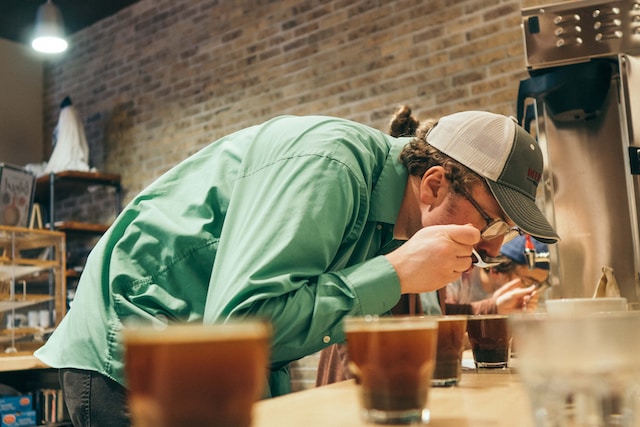£25 Minimum Order | FREE shipping on orders of £60 (FREE over £40 for Herts postcodes)
Things You Need To Know About Craft Beers As A Beginning Connoisseur

Welcome to the world of craft beer, where flavor is king and creativity knows no bounds. As a beginning connoisseur, you are about to embark on an exciting journey filled with unique tastes, intriguing styles, and a vibrant community of beer enthusiasts.
Craft beer is not just any ordinary beverage; it’s a work of art meticulously crafted by passionate brewers who pour their hearts into every batch. From hoppy IPAs to rich stouts and everything in between, there is a style to suit every palate.
In this article, we will guide you through the basics of craft beer – from understanding its origins and ingredients to exploring different styles and their characteristics. We will delve into the art of tasting and evaluating craft beers, helping you develop your palate and appreciation for the complexities within each brew. Additionally, we’ll explore how craft beer can be perfectly paired with various foods to enhance your culinary experiences.
Join us as we dive into the fascinating world of craft beers – where passion meets expertise, experimentation reigns supreme, and every sip tells a story. Get ready to become a true connoisseur as we share some essential things you need to know about craft beers.
The Basics of Craft Beer
Craft beer is all about exploring and enjoying a wide range of unique flavors and styles. To truly appreciate craft beer, it’s important to understand the basics of its brewing process and ingredients. Craft beers are typically brewed using traditional methods that involve four main ingredients: malted barley, water, hops, and yeast. The brewing process starts with malting the barley to release enzymes that convert starches into sugars. These sugars are then extracted in hot water, creating a sweet liquid called wort. Hops are added during boiling to balance the sweetness with bitterness and provide aroma. After fermentation by yeast, which consumes the sugars and produces alcohol and carbon dioxide, the beer is ready for enjoyment. Now that you know the fundamentals of craft beer brewing, it’s time to dive into exploring different beer styles – each with its own distinct characteristics and flavors.
Exploring Beer Styles
Discovering the vast array of beer styles will transport your taste buds on an exhilarating journey through a kaleidoscope of flavors and aromas. Whether you prefer hoppy IPAs, malty stouts, or crisp lagers, each style has its own unique characteristics that make it special. Understanding beer history is essential to appreciating the diversity of craft beers. From ancient civilizations brewing barley-based beverages to monks perfecting their recipes in monasteries, beer has a rich and fascinating past.
Brewing techniques also play a crucial role in creating different beer styles. The choice of ingredients, such as malted grains and hops, combined with fermentation processes and aging methods, contribute to the distinct flavors found in each brew. Exploring these techniques will deepen your understanding and appreciation for craft beers.
So now that you have learned about the basics of craft beer and explored various styles, it’s time to delve into the art of tasting and evaluating craft beers without missing a single note on this flavorful symphony.
Tasting and Evaluating Craft Beers
Get ready to elevate your beer tasting experience by honing in on the art of evaluating different brews and unlocking a world of flavors that will leave you craving for more. When it comes to craft beers, there are various techniques you can employ to fully appreciate their complexity. Begin by pouring the beer into a glass, allowing it to release its aromas. Take note of the color, clarity, and head formation as these can provide valuable clues about the beer’s quality and style. Then, take a small sip and let the flavors dance on your palate. Pay attention to the taste profile – is it malty or hoppy? Is there any sweetness or bitterness? To truly become an expert in craft beer evaluation, it’s important to also learn how to identify off flavors such as skunkiness or a metallic taste. By mastering these tasting techniques, you’ll be able to fully appreciate and savor every sip of craft beer. Now that you have refined your palate, let’s move on to exploring how different craft beers can be paired with food seamlessly.
| Technique | Description |
|---|---|
| Aroma | Assessing the scent given off by the beer |
| Appearance | Observing color, clarity, and head formation |
| Taste | Noting flavor profiles including sweetness, bitterness, maltiness |
Now that you have refined your palate through tasting and evaluating craft beers using various techniques such as aroma assessment and flavor profiling while also learning how to identify off flavors like skunkiness or metallic taste; it’s time to explore another exciting aspect – pairing craft beer with food!
Pairing Craft Beer with Food
When it comes to pairing craft beer with food, there is a world of flavors waiting to be explored. Complementing flavors is one of the key aspects to consider, as certain beers can enhance the taste profiles of different dishes. By carefully selecting the right beer to accompany your meal, you can create a truly exceptional dining experience that will leave you wanting more.
Complementing Flavors
To truly appreciate craft beers as a beginning connoisseur, you’ll love how the diverse flavors of different types of beer perfectly complement each other. Craft beers offer an extensive range of flavor profiles, from hoppy and bitter IPAs to malty and rich stouts. When exploring the world of craft beer, understanding how these flavors interact with each other is essential. The key lies in balancing tastes to create a harmonious drinking experience. For example, pairing a hop-forward IPA with spicy foods can help cut through the heat and enhance both the beer and the dish. Similarly, a smooth and caramel-like amber ale can beautifully accompany grilled meats or hearty stews. By appreciating the way craft beers’ flavors interact with various foods, you’ll be well on your way to enhancing the dining experience without missing out on any delightful combinations that await you in your journey as a craft beer connoisseur.
Enhancing the Dining Experience
Enhancing the dining experience with craft beer is a delicious and harmonious journey of flavors. Craft beer etiquette is an important aspect to consider when pairing these brews with food. Just as you would select wines to complement a meal, creating a beer tasting menu can elevate your dining experience to new heights. The key is to match the intensity and complexity of flavors between the dishes and beers. Start with lighter beers for appetizers and progress towards bolder ones for main courses. Don’t forget about dessert! Experimenting with sweet stouts or fruity sours can provide a delightful ending to your meal. By carefully selecting craft beers that enhance the flavors of each dish, you’ll create a symphony of tastes that will leave you craving more. Transitioning into the next section, let’s explore the vibrant craft beer community and its passionate enthusiasts who make this world so unique.
The Craft Beer Community
Join the craft beer community and discover a world of flavors, camaraderie, and endless possibilities. As a beginning connoisseur, immersing yourself in the craft beer community will expand your knowledge and deepen your appreciation for this art form. One way to engage with fellow enthusiasts is by attending beer festivals, where you can sample a wide variety of brews from different breweries while engaging in spirited conversations about flavor profiles, brewing techniques, and emerging trends. Another avenue to explore is homebrewing, which allows you to create your own unique concoctions and experiment with different ingredients. Being part of the craft beer community also means supporting local breweries, contributing to their success, and fostering a sense of belonging among like-minded individuals who share your passion for all things related to craft beer.
| Beer Festivals | Homebrewing | |
|---|---|---|
| Benefits | Exposure to new flavors | Creativity |
| Networking opportunities | Quality control | |
| Education on brewing process | Personalized recipes | |
| Celebration of craft beer culture | Sense of accomplishment | |
| Discovering new breweries | Community engagement |
By participating in these activities within the craft beer community, you’ll not only enhance your understanding but also forge meaningful connections with other enthusiasts who are just as passionate as you are. So why wait? Dive into this vibrant community today!





